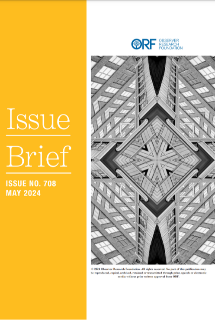
Canada unveiled its long-awaited
Indo-Pacific strategy on 27 November and joined the growing list of countries and groupings that have outlined their strategies for the Indo-Pacific region since 2017. The strategy emphasises the growing salience and importance of the region from a combination of diverse perspectives, and underscores its significance for Canada’s economic prosperity, security, and society and for “every issue that matters to Canadians.” It commits Canada to a deeper and substantive engagement with the region, promising a holistic focus by both the government and its people.
Key aspects
The strategy is aligned with the broader outlook of Canada’s allies and partners towards the Indo-Pacific region, including the United States (US), the United Kingdom (UK), the European Union (EU), Australia, Japan and the Republic of Korea. It outlines five strategic objectives: Promote peace, resilience and security; expand trade, investment, and supply chain resilience; invest in and connect people; build a sustainable and green future; being an active and engaged partner. The plan for each objective has been elaborated upon. Canada seeks to be an active player in seizing the region’s multiple opportunities and making its contribution in addressing the existing and emerging strategic challenges. It outlines the China challenge, with concerns about China’s strategic and motivated investments, coercive approaches, arbitrary application of laws, military capabilities, and attempts to realign the international order to its advantage. Like the strategies of the EU and the UK, it aims to cooperate and partner with China where needed and stand up and push back where necessary. Additionally, it plans to review all existing mechanisms and structures with China and diversify its investments in the region. It identifies India as a critical partner, and specific areas for enhancing cooperation have been indicated.
The strategy has a special emphasis on northern and western Pacific regions, and on strengthening cooperation with Japan, the ROK, Australia, and the ASEAN countries. This is particularly evident in the fields of security and defence. Specific mention of challenges posed by China in the South China Sea, East China Sea, and Taiwan Strait; strengthening regional defence architectures; augmenting naval presence and collaborative deployments; ensuring stability in the Korean peninsula; and enhancing defence and security relationships indicate a clear western Pacific focus. The strategy positions Canada as a potential partner for new initiatives and frameworks being led by the US, which in the future could include structures like the AUKUS—as informal security alliance between Australia, the UK and the US.
Enhancement in trade and investments with efforts to gain increased market access in the region have been indicated. Canada will seek to progress Free Trade Agreement with ASEAN, Comprehensive Economic Partnership Agreement (CEPA) with Indonesia, and an eventual CEPA with India after an interim trade agreement. It aims to leverage its strengths to partner in clean technologies, underwater mapping, remote sensing, fisheries, biodiversity protection, and blue economy experiences.
Distinctive features
In yet another interpretation of the geographical area, the strategy lists 40 countries that it considers a part of the Indo-Pacific region, which has been depicted on a map. From Pakistan in the west to Pacific Island countries (14) in the east, it includes Bhutan, Nepal, and Mongolia. Statistics and data points are accordingly linked with these 40 countries. It highlights that Canada itself is a Pacific nation—and not included in the list of Indo-Pacific countries—and that the Indo-Pacific is in its neighbourhood.
It introduces a new term—people of Indo-Pacific origin, and stresses that the largest diaspora in Canada is of Indo-Pacific origin. It seeks to accord priority to people-to-people exchanges with the region, and feminist international assistance. It also introduces the concept of a whole-of-society approach, wherein businesses, industry, academic institutions, think tanks, media, professionals, activists, and the broader civil society all play a dominant role. It, therefore, seeks to position itself as a strategy of the nation, and not just of the government. In doing so, it attempts to align its
domestic agenda of diversity, reconciliation, environmentalism and immigration, with its foreign policy imperatives. Unlike some other strategies, it does not include separate sections on connectivity or security, and there is no hint of any strategic autonomy.
Specific areas and steps for engagement with Australia, ASEAN countries, China, India, Japan, and the ROK have been outlined. However, the engagement plan with China is put forward in a different way from the others and is described at various levels—domestic, bilateral, regional, and multilateral. The underlying theme is the apprehension and risks related to deeper engagement with China, and the
desirability of diversifying away from it. The strategy also refers to protecting Canadian businesses and its economy from investments by China’s state-owned enterprises. While it highlights the strategic challenge of great-power competition in the region, it positions itself unambiguously with its allies and partners, stating that commitments have also been tailored to meet their needs. About Taiwan, it reaffirms its ‘One China’ policy, opposes any unilateral action that threats the status quo, and stresses its plan to continue to grow its ties. The strategy is a clear signal to China about the new direction being adopted by Canada. It also plans to invest in improving Canada’s knowledge and understanding of China, and the region.
Expectedly, the
Global Times stated that this strategy is overambitious and full of malice and prejudice towards the Chinese people. It accused Canada of plagiarism and copying from the US documents, and highlighted its role as a “cheerleader for Cold War 2.0” while playing a subordinate position to Washington.
Implementation
The strategy had been under preparation and review for over three years. It has been reported that several drafts had been vetted. The text of the released version is concise, and the broad approach is pragmatic, with clarity on goals and objectives. There are adequate descriptions of key steps planned towards implementation. As per reports, there were multiple iterations for resource and funding support, which have finally been made more realistic. An
allocation of US $ 2.3 billion over five years is planned, of which about US $ 750 million is for FinDev (Canada’s development finance institution) and US $ 492 million is for expanding naval presence and participation in regional military exercises. A fresh allocation of
US $ 74 million for immigration support has also been indicated. It is not clear if funding support will be increased for rights-based organisations in the region, given the record of mixed outcomes in the past.
As done by some other countries, Canada plans to appoint a special envoy for the Indo-Pacific region, which should facilitate necessary coordination at policy and operational levels. A new diplomatic position is also planned in Hawaii, which should enable effective liaison with the headquarters of the US Indo-Pacific Command.
No specific review or monitoring mechanism has been indicated, but it may be announced soon. The strategy brings with it the potential to add to the ongoing strategic competition and rivalry in the region. But collaborative and meaningful implementation can also position Canada as a mature and key player in the Indo-Pacific region. To a large extent, action on the fifth and last objective of “Canada as an active and engaged partner to the Indo-Pacific” will drive the implementation plan for all its objectives.
The views expressed above belong to the author(s). ORF research and analyses now available on Telegram! Click here to access our curated content — blogs, longforms and interviews.



 Canada unveiled its long-awaited
Canada unveiled its long-awaited  PREV
PREV


